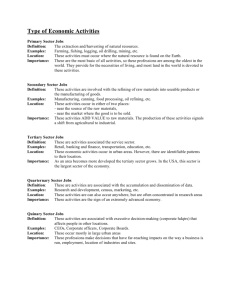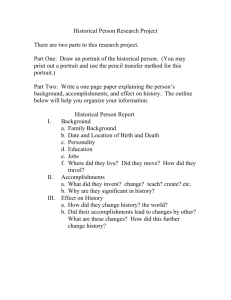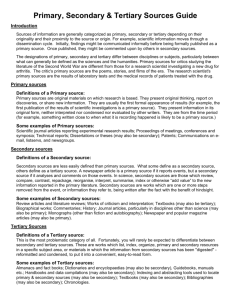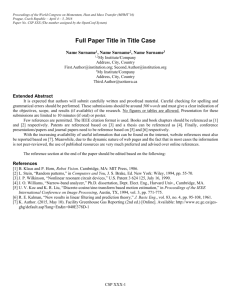SAAM Subject Term Guide
advertisement
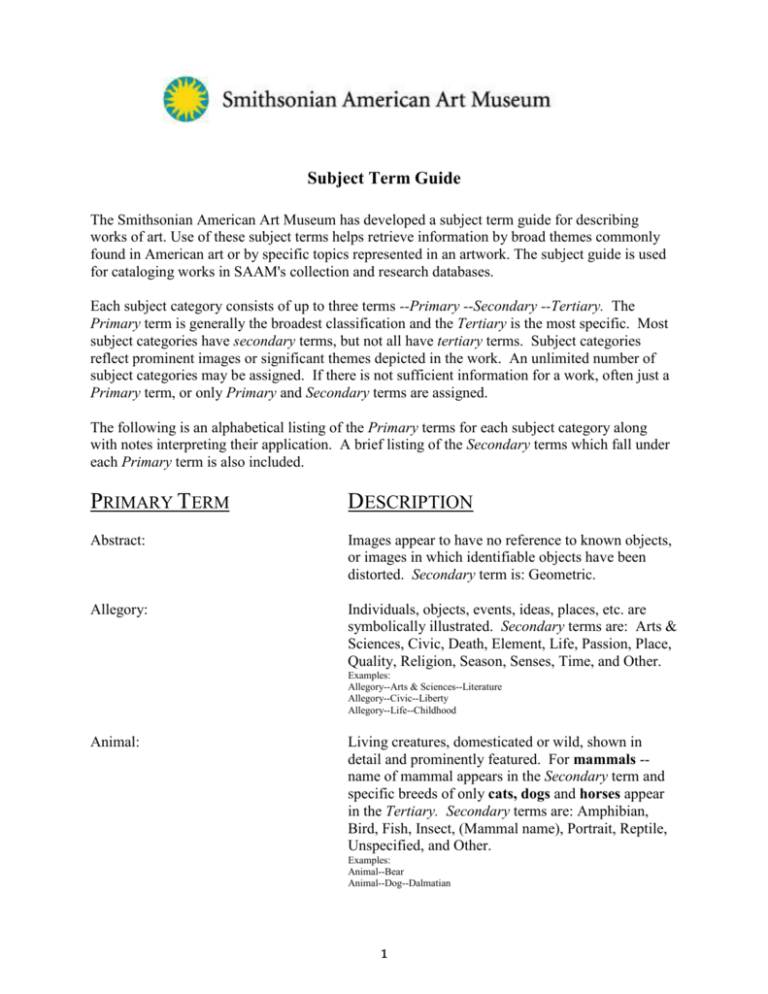
Subject Term Guide The Smithsonian American Art Museum has developed a subject term guide for describing works of art. Use of these subject terms helps retrieve information by broad themes commonly found in American art or by specific topics represented in an artwork. The subject guide is used for cataloging works in SAAM's collection and research databases. Each subject category consists of up to three terms --Primary --Secondary --Tertiary. The Primary term is generally the broadest classification and the Tertiary is the most specific. Most subject categories have secondary terms, but not all have tertiary terms. Subject categories reflect prominent images or significant themes depicted in the work. An unlimited number of subject categories may be assigned. If there is not sufficient information for a work, often just a Primary term, or only Primary and Secondary terms are assigned. The following is an alphabetical listing of the Primary terms for each subject category along with notes interpreting their application. A brief listing of the Secondary terms which fall under each Primary term is also included. PRIMARY TERM DESCRIPTION Abstract: Images appear to have no reference to known objects, or images in which identifiable objects have been distorted. Secondary term is: Geometric. Allegory: Individuals, objects, events, ideas, places, etc. are symbolically illustrated. Secondary terms are: Arts & Sciences, Civic, Death, Element, Life, Passion, Place, Quality, Religion, Season, Senses, Time, and Other. Examples: Allegory--Arts & Sciences--Literature Allegory--Civic--Liberty Allegory--Life--Childhood Animal: Living creatures, domesticated or wild, shown in detail and prominently featured. For mammals -name of mammal appears in the Secondary term and specific breeds of only cats, dogs and horses appear in the Tertiary. Secondary terms are: Amphibian, Bird, Fish, Insect, (Mammal name), Portrait, Reptile, Unspecified, and Other. Examples: Animal--Bear Animal--Dog--Dalmatian 1 PRIMARY TERM DESCRIPTION Architecture: Architecture exterior: Architecture interior: Exterior or interior views of structures that are identified and/or shown in sufficient detail to of interest as documents of style. Proper names of buildings, boats, bridges, etc. appear in the Tertiary term. Secondary terms are: Art Building, Boat, Bridge, Castle, Civic, Classical, Commercial, Design, Detail, Domestic, Education, Farm, Industry, Lighthouse, Machine, Military, Monument, Religious, Ruins, Science, Studio, Vehicle and Other. Examples: Architecture--Civic--Library Architecture--Detail--Window Architecture interior--Domestic--Kitchen Cartoon: Figures or narrative scenes in which features are intentionally exaggerated out of naturalistic proportion. Any political or satirical cartoon as well as comic strip. Secondary terms are: Comics, Political. Example: Cartoon--Comics--Pink Panther Ceremony: A formal act performed as prescribed by ritual, custom, or etiquette. Secondary terms are: Civic, Coronation, Dance, Festival, Funeral, Holiday, Indian, Military, Procession, Religion, Royal, Wedding and Other. Examples: Ceremony--Civic--Election Ceremony--Festival--Olympics Children: Depictions of children at play or performing home activities. No Secondary terms. 2 PRIMARY TERM DESCRIPTION Cityscape: Used for views of or within populated or built environments which are characteristic of incorporated communities, villages, towns, or cities. State or country names are referenced in the Secondary term and city names are referenced in the Tertiary term. If only a general US location is known, United States appears in the Secondary and the location appears in the Tertiary. Secondary terms are: (name of country), (name of state), Bird's Eye View, Celestial, Imaginary, River, Ruins, Season, Street, Time, Town, United States, Water, Weather, and Wharf. Examples: Cityscape--Missouri--St. Louis Cityscape—Italy--Rome Cityscape--River--Mississippi River Disaster: A sudden calamitous event bringing great damage, loss or destruction. Secondary terms are: Accident, Avalanche, Drought, Earthquake, Famine, Fire, Flood, Landslide, Shipwreck, Storm, and Volcanic Eruption. Examples: Disaster--Accident--Car Accident Disaster--Earthquake Disaster--Storm--Hurricane Dress: Apparel or clothing that is significant, or may be of interest to researcher. Secondary terms are: Accessory, Ceremonial, Costume, Ecclesiastical, Ethnic, Historic, Royal, Theater, and Uniform. Examples: Dress--Accessory--Eye Wear Dress--Historic--Pioneer Dress Emblem: An object or representation that serves as a symbol. Secondary terms include: Coat of Arms, Cross, Heart, Masonic, Zodiac, etc. Examples: Emblem--Coat of Arms Emblem--Zodiac Equestrian: Figure(s) depicted on horseback. Includes horseback riding, cowboys, Indians and military personnel. No Secondary terms. 3 PRIMARY TERM DESCRIPTION Ethnic: Any depiction of people whose nationality, race, tribal, religious, linguistic or cultural origin/background is emphasized in visual terms or in title. The most specific ethnic group is always referenced in the Secondary. Secondary terms are: (nationality name such as --African, French, Russian, etc.) and (ethnic group name such as –AfricanAmerican, Hispanic, Indian, Asian-American, etc.) Tertiary terms include Native-American tribe names. Examples: Ethnic--Chinese Ethnic--Indian--Hopi Fantasy: Used to reference weird, bizarre, fantastic, imaginary or incongruous juxtapositions of animals and beings. Narrative scenes from literature are not included. Secondary terms are: Animal, Dragon, Elf, Fairy, Ghost, Monster, and Winged Being. Examples: Fantasy--Animal--Bird Fantasy--Ghost Figure: Figure female: Figure male: Used for generic human form. If sex cannot be determined, figure is used without male of female. If the identity of the figure is known, the work is referenced under the subject category Portrait, instead of Figure. Secondary terms are: Bust, Child, Elderly, Fragment, Full length, Head, Knee length, Nude, Torso, and Waist length. Examples: Figure--Bust Figure--Fragment--Foot Figure female--Child--Full length Figure male--Elderly--Bust Figure group: Used for generic figures of adults in closely knit groupings. Figure group implies mixed sexes. If the identity of the figures is known, the work is referenced under the subject category Portrait, instead of Figure. Secondary terms are: Artist & Model, Bust, Elderly, Family, Female, Female & Child, Male, Male & Child, and Nude. Examples: Figure group--Family--Mother & Child Figure group--Female--Nude 4 PRIMARY TERM DESCRIPTION History: Depictions of unique events specifically identified by date and/or circumstances; representation may be contemporary to the event and intended as documentary record, or may be an imagined and idealized reconstruction of an event. Country names are generally cited in the Secondary with the historical event in the Tertiary. For pre-Renaissance time periods the terms Ancient or Medieval are cited as the Secondary term and country names are in the Tertiary. Secondary terms are: (country names such as France, Italy, United States), Ancient, Arts & Sciences, Exploration, Medieval, Prehistoric, and Religion. Examples: History--France--Revolution History--United States--Civil War History--Ancient--Egypt History--Medieval--England Homage: Used when work is a memorial or tribute to someone and not an actual portrait of that person. The Secondary terms are the Last name, First name of the individual. Example: Homage--Lincoln, Abraham 5 PRIMARY TERM DESCRIPTION Landscape: Used for views of natural scenery on land. Figures, animals, buildings, and other objects may be included as secondary elements in the composition. Scenes of the United States and Canada are referenced with the state or province name in the Secondary and the city name in the Tertiary. Foreign landscapes (excluding Canada) are referenced with the name of country in the Secondary and name of city in the Tertiary. If only a general US location is known, United State appears in the Secondary and the location name appears in the Tertiary. Secondary terms are: (name of state or Canadian province), (name of country), Beach, Bird's Eye View, Building, Canyon, Celestial, Cemetery, Coast, Composition, Desert, Farm, Foreign, Forest, Garden, Imaginary, Island, Lake, Marsh, Mountain, Orchard, Panorama, Park, Phenomenon, Plain, River, Road, Rocks, Season, Time, Town, Tree, Tropic, United States, Valley, Water, Waterfall, Weather, and Wharf. Examples: Landscape--Virginia--Richmond Landscape--Beach--Miami Beach Landscape—Canada-Toronto Landscape--Canyon--Grand Canyon Landscape--Time--Sunrise 6 PRIMARY TERM DESCRIPTION Literature: An established literary reference is evident in the subject matter of the painting or sculpture. If name of author and title of work are known, the author is referenced in the Secondary and the title is referenced in the Tertiary. If the title of the publication is a magazine or newspaper, the name of the publication is referenced in the secondary. If the character name is known, the term Character is referenced in the Secondary and the character's name is referenced in the Tertiary. Secondary terms are: (name of author), (name of magazine or newspaper), Character, and Proverb. Examples: Literature--Dante--Inferno Literature--Saturday Evening Post Literature--Character--Hiawatha Mythology: Characters or narrative scenes derived from the myths about the history and origin of a people and their ancestors, deities, and heroes. Secondary terms are: American Indian, Classical, Egyptian, Nordic, Oriental, and Other. Examples: Mythology--Classical--Prometheus Mythology--Egyptian--Phoenix Mythology--Oriental--Genii Mythology--Other--Hawaiian Object: Used to reference significant objects in a scene or when the artwork is an object. (See the subject category Still Life for depictions of objects arranged for a pictorial composition.) Secondary terms are: Art Object, Art Tool, Flower, Foliage, Foodstuff, Fruit, Furniture, Game, Letter, Musical Instrument, Numeral, Tool, Toy, Vegetable, Weapon, Written Matter, and Other. Examples: Object--Foodstuff--Egg Object--Flower--Rose Object--Toy--Kite 7 PRIMARY TERM DESCRIPTION Occupation: Used to reference types vocations or activities. Performers, such as musicians and actors, are referenced separately under the subject category Performing Arts. Secondary terms are: Art, Beggar, Communication Arts, Cook, Craft, Crime, Domestic, Education, Farm, Hunter, Industry, Labor, Law, Medicine, Military, Monetary, Occult, Political, Religion, Science, Service, Sport, Transportation, Vendor, Writer, and Other. Examples: Occupation--Crime--Pirate Occupation--Domestic--Nursemaid Occupation--Monetary--Banker Occupation--Service--Policeman Performing Arts: Used when performance is a major theme of the artwork, or whenever the occupation of the person is that of a performer or entertainer. Includes performances in theaters and home recitals as well as casual representations of musical or acting abilities. Secondary terms are: Circus, Dance, Music, Opera, Theater, and Other. Examples: Performing Arts--Circus--Acrobat Performing Arts--Opera--Verdi Performing Arts--Other--Comedian Portrait: Portrait female: Portrait male: Portrait group: If sex of sitter cannot be determined, Portrait is referenced without male or female. Proper names appear under the Secondary term with Last Name, Name. Tertiary terms may reference length of pose. Examples: Portrait male--Washington, George--Bust Portrait female--Washington, Martha--Waist length Portrait group--Family--Mother & Child Primitive: This term is used for paintings only. Secondary terms are: Fractur, Mourning, and Theorem. Examples: Primitive--Mourning Primitive--Theorem 8 PRIMARY TERM DESCRIPTION Recreation: Depictions of the sports, games and leisure activities. Secondary terms are: Cafe, Carnival, Church, Courting, Craft, Dancing, Dress Up, Fair, Gambling, Leisure, Party, Picnic, Sport & Play, Theater, and Tourism. Examples: Recreation--Dancing Recreation--Leisure--Eating & Drinking Recreation--Leisure--Reading Recreation--Sport & Play--Checkers Religion: References religions, personages, and events. Specific personages or iconographic themes are prefaced by New Testament or Old Testament under the Secondary term. Secondary terms are: Angel, God, Martyr, Satan, Saint, New Testament, Old Testament, (name of a religion such as Buddhism or Mormonism). Examples: Religion--Angel Religion--Saint--St. Francis Religion--New Testament--Crucifixion Religion--Old Testament--Adam & Eve Religion--Judaism Skeleton: References depictions of the internal vertebrate structure composed of bones and cartilage in humans and animals. This term is used if it is impossible to determine if the skeleton is human or animal. Secondary term: Skull. Example: Skeleton--Skull State of Being: References obvious aspects of the human condition. Secondary terms are: Death, Emotion, Evil, Handicapped, Illness, Mood, Phenomenon, and Other. Examples: State of Being--Emotion--Anger State of Being--Handicapped--Blind State of Being--Phenomenon--Dream State of Being--Other--Widow 9 PRIMARY TERM DESCRIPTION Still Life: Depictions of inanimate objects, generally removed from natural context, arbitrarily arranged for pictorial composition. This term is more likely to be used for paintings. Secondary terms are: Art Object, Art Tool, Flower, Foliage, Foodstuff, Fruit, Furniture, Game, Musical Instrument, Numeral, Tool, Toy, Trompe L'Oeil, Vegetable, Weapon, Written Matter, and Other. Examples: Still Life--Flower--Rose Still Life--Game Still Life--Vegetable--Tomato Study: References studies, maquettes, and sketches when the word study or sketch appears as part of the title or when the work is an actual study for a larger or more complete composition. Secondary terms are: Academic Study, Anatomical Study, Botanical Study, Maquette, and Technical Study. Examples: Study--Botanical Study--Flower Study--Maquette Travel: Detailed depictions of the equipment and/or operations of vehicles of transportation. Used when travel is the dominant theme and motion is evident. Secondary terms are: Air, Land, and Water. Examples: Travel--Air--Balloon Travel--Land--Subway Travel--Water--Submarine Waterscape: Used for views dominated water in which land plays a subordinate role. Proper names are referenced in the Tertiary after appropriate Secondary. Secondary terms are: Bay, Boat, Canal, Celestial, Channel, Coast, Harbor, Inlet, Lake, River, Sea, Season, Sound, Time, Weather, and Wharf. Example: Waterscape--Lake--Lake Michigan Waterscape--Time--Sunset Waterscape--Weather--Mist Western: References scenes of western subject matters such as Cowboys and Indians, Log Cabins, Buffalo, Rocky Mountains, or Deserts. There are no Secondary terms. 10



